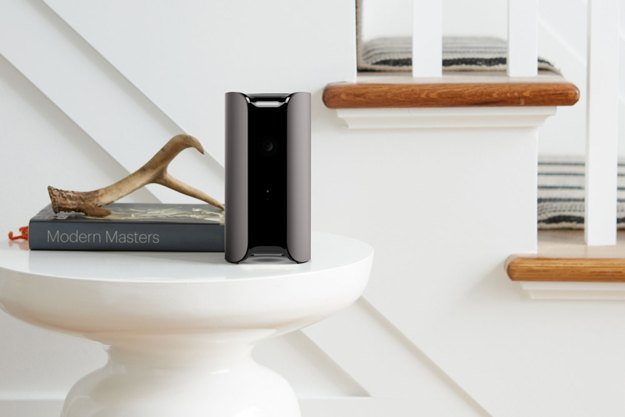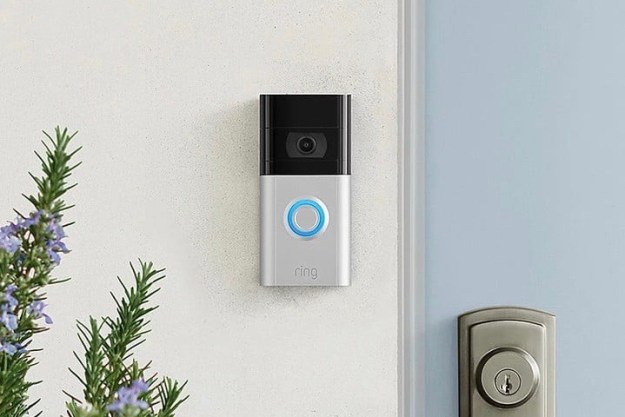
“The Canary View is compelling for value hunters, but its motion detection isn't reliable.”
- Compact, well-designed hardware
- Fantastic 1080p day and night imaging
- Geo-fencing features supporting automatic activation
- Works with Amazon Alexa, Google Home and Wink
- App stability issues during setup
- Patchy motion detection
- Subscription membership required for full features
Launched on Indiegogo way back in 2013, the original Canary All-in-One was a pioneering smart home security solution, integrating a surveillance camera, 90-decibel siren, and climate monitor. Broadly effective, the debut suffered from a few rough edges that were subsequently refined in last year’s Canary Flex ($199), which dropped the siren and climate monitor features in favor of a sleeker design, weatherproofing, A.I. support, and (as the name suggests) flexible mounting options. We loved it.
With the Canary View at just $99, our first thought is that it must be really basic. Not so. More akin to the original Canary in design, there’s no siren or climate monitor, but 1080p imaging, a 147-degree field of vision, motion detection with activity zones, night vision, and optional two-way audio are all included. Add smart home integration with Amazon Alexa, Google Home, and the Wink Smart Home Hub, and Canary View looks to be a compelling proposition for value hunters. On paper at least.
So, what’s the catch?
At this price, we assumed there would be issues with the look and feel of the device. There’s not. Packing the same dimensions and cylindrical design as the All-in-One, Canary View looks and feels great in the hand. Black glossy plastics are wrapped in a satin, graphite-colored frame, offering protection against knocks, bumps and smudgy fingerprints. It may not have the grace or utility of Canary Flex when it comes to mounting, but a long, 2-meter micro-USB power cable allows plenty of positioning flexibility, while the branded power connector adds a touch of class.
What you should be aware of is that Canary offers an optional membership ($10 per month or $99 annually) that adds a range of feature enhancements to the camera. Home monitoring and motion detection is included when you purchase it, but membership adds 30-day video history, two-way audio, and desktop streaming. The warranty is also boosted from one to two years. Opt for a two-year subscription when you purchase the device, and you get the camera for free. It’s the mobile phone service business model, tweaked for smart home security.
How’s performance?
Overall, we found performance to be mixed. During setup, Canary’s good-looking
Packing the same dimensions and cylindrical design as the All-in-One, Canary View looks and feels great in the hand.
From there, life with Canary View is quite simple. Select from three modes – Home, Away, or Night to toggle imaging, motion detection and alerting features. You can also control it using the camera’s geo-fencing feature, which allows you to switch modes automatically as you come and go.
Daytime image quality is fantastic – as good as we’ve seen in any smart home security camera we’ve reviewed recently, at any price point. Streamed live video is reasonably sharp, without the smears and blockiness we’ve experienced with competitor’s cameras. The field of vision offers sufficient coverage but doesn’t quite have the reach of budget favorites like the Honeywell Lyric C2. Like many of its peers, Canary View also overexposes window areas in daylight.
- 1. Guardzilla 360
- 2. Canary View
A ring light, embedded in the camera’s base, helps Canary View deliver great quality images in darkened rooms. The integrated infrared LEDs provided illuminated black and white images with decent range.
Daytime image quality is fantastic – as good as we’ve seen in any smart home security camera we’ve reviewed recently, at any price point.
There’s a lag of about a second from live motion to what’s shown on your mobile screen, which is acceptable, but Canary View does need a buffer of 5-6 seconds to start streaming. This is reasonably typical but still a target for the company to reduce. When streaming to the desktop, the delay extends to around 15 seconds.
We were less impressed by Canary View’s notifications. When motion detection was triggered in Away mode, we found it could take up to two minutes for an alert to reach our phone. Given that competitors can fire notifications within seconds, this delay is excessive. More worryingly, even set to maximum sensitivity, the camera completely failed to detect motion at times, despite us repeatedly walking around a monitored room. Canary told us that notifications and video capture can be suppressed by features intended to avoid multiple alerts of a similar kind or by a “stable motion algorithm” designed to filter out alerts from ceiling fans, TV images and the like. This all sounds like clever stuff, but neither feature should be activated by a person simply walking around a room. A motion-detection feature should detect motion, with options to activate and disable smarter, “under-the-hood” features as necessary. As such, our confidence in Canary View’s motion detection was heavily dented.
Any advanced features?
While competitors are racing to add third-party integrations to their devices, Canary View already supports Amazon Alexa, Google Home, and Wink. Amazon’s integrations allow you to stream video to the Echo Show, Echo Spot and Fire TV devices while you can ask the Google Assistant to tell you who’s currently at home, with results emanating from Canary View’s geo-fencing feature.
Elsewhere, we liked the ability to add phone numbers for emergency services to the Canary app, with an on-screen button facilitating a quick call if help is required. You’ll be happy to hear that all communications sent between the camera, the cloud, and connected devices are securely encrypted, ensuring maximum privacy.
If you decide to go for Canary Membership, two-way audio is enabled, with the camera’s integrated speaker and microphone offering higher quality audio than many competitors. However, it’s a stretch to call this a “premium” feature and should be available to all.
The Canary team made a few key improvements to the technology, including the ability to filter based on people’s movements or any motion. That makes it easier for you to differentiate between a person coming through your door and your cat disturbing your house plant. This feature cuts down the number of false positives you’ll receive from the smart camera.
Should you buy it?
While a $99 1080p smart home camera is mouth-watering proposition, our concerns over Canary View’s patchy motion detection prevent us from fully recommending the device. That’s a shame because, otherwise, there’s a lot to love. It’s a good looking, well-built device offering fantastic image quality with a slick and simple app that, apart from a few initial stability issues, delivers a great experience.
Canary isn’t alone in propping up their business model with ongoing subscriptions, and it certainly boosts the camera’s utility. Over time, however, those subscription fees really mount up, so if you’re looking for best value, we’d point you towards the $130 Swann Smart Security Camera or Honeywell Lyric C2 which offer similar features, more robust motion detection and no ongoing fees.
Warranty information
The Canary View is sold with a one-year warranty, but this can be boosted to two-years with purchase of a Canary membership ($10 per month or $99 per year).
Our Take
The $99 Canary View is almost a revelation, offering good looks, first-class imaging, and integrations with both Amazon
Is there a better alternative?
At $130, the Swann Smart Security Camera may cost just a little more than Canary View but is rechargeable, fully wireless, and can be used both indoors and outdoors. Performance is more robust and you don’t need to worry about subscription fees. It’s a brilliant pick for a budget smart home security camera.
How long will it last?
Canary has built a strong track record in delivering feature enhancements to its range, but the company has also been accused of switching features into paid subscription plans that were previously available at no charge. It’s clear that the company’s business strategy relies on ongoing service revenue, so given Canary View’s low initial price point, you can expect the company to work hard to convince you to upgrade to membership.
Updated June 2018 to note that the Canary View now has person detection capabilities in order to filter family from strangers.
Editors' Recommendations
- Blink Mini 2 vs. Ring Stick Up Cam Pro: Which is the best security camera?
- Does the Pan-Tilt Mount work with the Blink Mini 2?
- Best security camera deals: Ring, Arlo, Blink and more on sale
- Does the Ring Stick Up Cam Pro rotate or swivel?
- Ring Stick Up Cam Pro vs. Canary Pro: Which is the better security camera?













